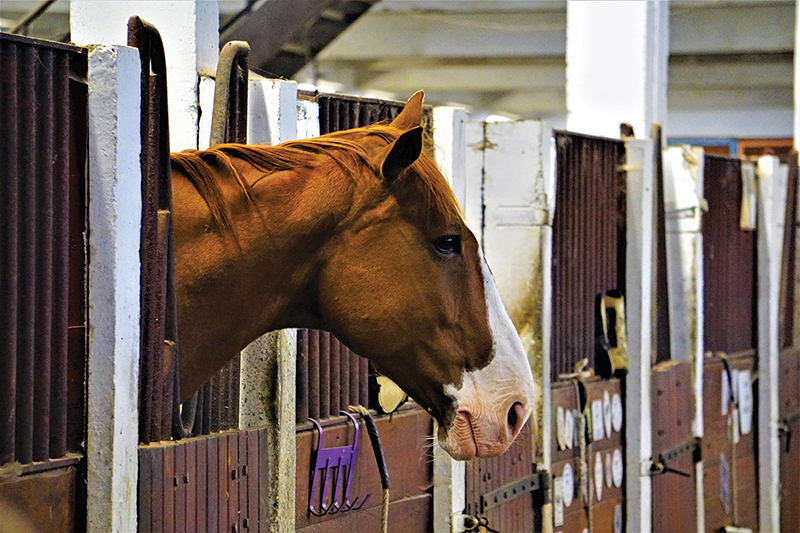Equine gastric ulcer syndrome is a common and significant cause of morbidity in horses of all breeds and uses. The syndrome includes both equine squamous gastric disease (ESGD) and equine glandular gastric disease (EGGD), which have differing etiologies and risk factors.
ESGD is known to be caused by direct acid injury to the squamous gastric mucosa, which has limited defense mechanisms and is not normally exposed to pH <4. Associated risk factors are related to decreased intra- gastric pH and increased exposure of squamous mucosa to gastric acid, typically due to fasting and/or exercise.
In contrast, EGGD is believed to result from breakdown of normal mucosal defense mechanisms and subsequent acid injury. Its underlying pathology may be inflammatory in origin, and identified risk factors include frequency of exercise, breed, and experience level of the horse.
Protecting Critically Ill Horses
Equine gastric ulcer syndrome is of particular concern in critically ill patients, which often simultaneously experience multiple risk factors for gastric ulcers, including transport, stress, fasting, and NSAID administration. To protect against the development of gastric ulcers in critically ill horses, it is common to initiate pharmacologic prophylaxis with omeprazole and/or sucralfate. However, these drugs have different mechanisms of action and may not be equally effective at preventing ESGD and EGGD.
Omeprazole has been the mainstay of treatment of gastric ulcers in horses and human subjects for many years. Omeprazole suppresses gastric acid secretion by inhibition of the hydrogen/potassium ATP pump in parietal cells, resulting in an increased intragastric pH.
Sucralfate exerts gastroprotectant effects through multiple mechanisms of action, including improved mucosal blood flow, interaction with fibroblast and epidermal growth factors, improved angiogenesis and epithelialization, inactivation of pepsin, and adsorption of bile acids.
Study Design
To develop evidence-based clinical recommendations for ulcer prophylaxis, we evaluated the efficacy of either omeprazole or sucralfate given as monotherapy for the prevention of gastric lesions in fasted horses treated with NSAIDs (flunixin).
In our study, 14 healthy horses received either omeprazole (1 mg/kg PO q24h) or sucralfate (20 mg/kg PO q8h) while undergoing a feed-fast/NSAID protocol. After an 8-week washout period, the horses received the alternate treatment. We used serial gastroscopy, ultrasound, and hematology to document treatment effects.
Findings
Equine squamous gastric disease developed or worsened under both treatments. Median ESGD scores were lower following treatment with omeprazole compared with sucralfate, although the effect of treatment on ESGD score just approached statistical significance. This finding suggests that suppression of gastric acid by omeprazole was at least partially protective against ESGD in fasted horses exposed to NSAIDs.
There was a statistically significant effect of treatment on equine glandular gastric disease score, with lower median EGGD scores following treatment with omeprazole than with sucralfate. Although there are multiple theoretical mechanisms through which sucralfate could exert protective effects on the gastric glandular mucosa, the findings presented here suggest that sucralfate alone is not effective for prevention of EGGD in fasted horses administered flunixin.
Horses receiving sucralfate were significantly more likely than horses receiving omeprazole to have increased maximum right dorsal colon wall thickness as measured by ultrasound. Only one horse experienced clinical signs of large intestinal inflammation while receiving sucralfate and flunixin. Our findings raise concern that coadministration of sucralfate with flunixin may be associated with increased risk of large intestinal complications in horses. Alternatively, it may be that the difference between treatments reflects a protective effect of omeprazole against NSAID-associated colitis. The interaction between gastroprotectant drug and dose, concurrent NSAID administration and lower gastrointestinal tract complications warrants further investigation.
We found no effect of treatment on any hematology parameters.
All horses that completed the study showed subjectively decreased appetite and dull demeanor by the end of treatment. However, none exhibited overt signs of colic, despite severe ESGD and EGGD in some horses. It is possible that the anti-inflammatory effects of flunixin ameliorated clinical signs of gastrointestinal discomfort in these horses. Sucralfate binding to ulcerated mucosa may have also provided some local pain relief.
Of the two gastroprotectant medications studied, omeprazole should be considered for mitigation of equine gastric ulcer syndrome in horses exposed to the dual risk factors of fasting and flunixin meglumine administration, although further study is warranted.
This article has been excerpted from: Effect of omeprazole and sucralfate on gastrointestinal injury in a fasting/ NSAID model. Rebecca Bishop, DVM: Ann Kemper, DVM; Pamela Wilkins, DVM, MS, PhD, DACVIM-LAIM, DACVECC; and Annette McCoy, DVM, MS, PhD, DACVSLA. Equine Vet J. 2021;00:1–9. https:// doi.org/10.1111/evj.13534




